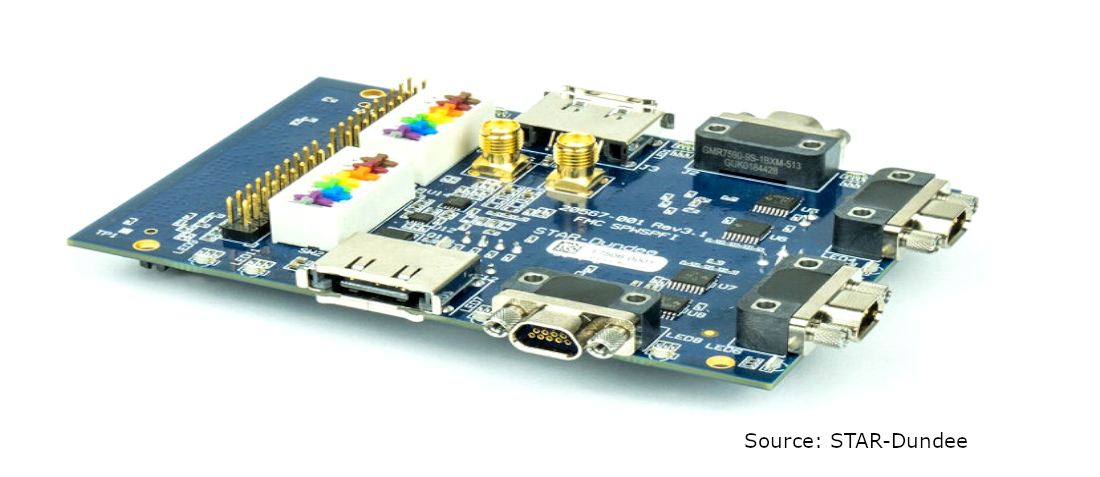
SpaceWire to SpaceFiber shift
- Posted by Pawel Adamiec
- On December 12, 2019
- 0
FMC SpaceWire/SpaceFibre Board
What is SpaceFiber?
The easiest response could be: SpaceFiber is a multi-Gbits/s, on-board network technology for spaceflight applications which complements well known SpaceWire network and both are for the satellites that, what Ethernet for us on the ground.
Digging into details: SpaceFibre is the successor of (and is compatible with) the very popular SpaceWire protocol but allows 15 times higher data rates per lane (up to 6.25 Gbps). It has fault detection and recovery as well as deterministic communication mechanisms built into the hardware and can operate via copper and optical fibre. The reduction of a harness is high compared to SpaceWire, with 50% when using optical fibres and more than 90% when comparing per bit transferred. The SpaceFibre standard (ECSS-E-ST-50-11C) is currently in public review and several Intellectual Property (IP) cores are readily available for the implementation into space-qualified FPGAs. As a future standard, there is ongoing work on SpaceFiber routers and ASICs.
SpaceFibre incorporates quality of service (QoS) using virtual channels to provide multiple independent communication channels over a single physical link. Each channel provides priority, bandwidth reservation and scheduled QoS. These QoS mechanisms operate together resulting in very versatile QoS and providing “babbling node” protection and scheduled, deterministic communication without wasting any network bandwidth.
Fault detection, isolation and recovery (FDIR) support is integrated in SpaceFibre, detecting, isolating and recovering from faults in the link where they occur, which prevents faults from propagating and causing further errors. The FDIR capability of SpaceFibre provides transparent recovery from transient errors.
Low latency broadcast messages are provided in SpaceFibre which enable the rapid signalling of events, reporting of errors, and distributing of system time information.
Very importantly SpaceFibre has been designed to be compatible with SpaceWire at the packet level, which means that existing SpaceWire equipment can be readily integrated into a SpaceFibre network without modification to that equipment. A simple bridge connecting a SpaceWire interface to a SpaceFibre virtual channel is all that is necessary, and the SpaceWire traffic flowing over a SpaceFibre virtual channel gains the QoS and FDIR characteristics that SpaceFibre provides.
Features
- Allows very high-speed streaming of data (up to 20 Gb/s) with only minimum buffer requirements.
- Offers also deterministic communication through virtual channel isolation. This is fully implemented in hardware and extreme tight timing requirements can therefore be met.
- Provides very low latency and jitter (no store-and-forward, no embedded software).
- Has a low protocol overhead that is independent of packet size.
- Includes a mechanism to detect errors on the link and to recover from them automatically by re-transmitting of data. The re-transmission is on a point-to-point basis with extreme fast reaction time (< 1us).
- Has a built-in flow-control mechanism.
- Does not restrict the sizes of packets.
- Simple networks are easily configured by hand, only larger networks might need specific software tools.
- Offers “broadcast messages”, which have minimum latency due to being prioritized over other data traffic. These messages are used for time-synchronization, interrupts, error codes and similar tasks.
- SpaceFibre can easily be embedded into systems without the need for proprietary software.
At Alter Technology we have already gained experience with both technologies SpaceWire and SpaceFiber by components and system (HW ans SW) testing under different scenarios, from simple characterization to environmental and radiation tests for ESA missions like ExoMars and JUICE to name a few.

AXON – AXOMACH® cable (source Axon web page)
Contact with our expert
- Image Sensors: Characterization according to the EMVA 1288 standard - February 15, 2022
- Development of a NIR-VIS-UV lidar echo emulator - October 7, 2021
- LIDAR echo emulator - October 7, 2021

0 comments on SpaceWire to SpaceFiber shift